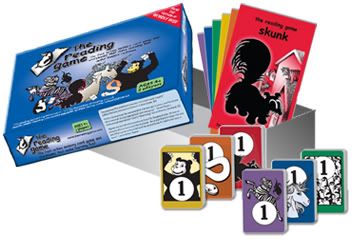We all know that a strong foundation in reading is essential for the future academic success of our children. Many moms I have spoken with are afraid to commit to homeschooling, because they are afraid they will not give their children the foundation they need in this important subject area. Enter: the reading game.
Created by Kenneth Hodkinson, author of Wordly Wise, the reading game makes learning to read easy, fast and fun!
From the company website:
The Reading Game is a
fast-action memory card game.
The Cards & Books work
together to make learning to read exciting and enjoyable.
The Skunk story, Book One
in the series, is told using
only those thirty words.
There are six books each with six corresponding sets of cards. Upon completion of all six levels, a child will have built a reading vocabulary of 180 words. More than half of those words are among the 100 most frequently used words in the English language.
How this works
Children play a memory type card game one on one with their teacher or an older/more proficient reader. Each color-coded level is broken down in six even smaller levels. Students learn only five words at a time, building up to a reading vocabulary of 30 words by the time a level is completed. When the color level is mastered, the child will be able to read the corresponding book made up of the 30 words learned during the memory game.
How this worked for us
We had great fun with this game. I used it with AJ8 and AC5. AJ8 has had a pretty good phonics foundation, so she could sound out most of the unfamiliar words in the first level. Within three rounds of play,(I keep lessons short, only about 10 minutes per child.) she was able to read the Level 1 book. At htis point, I could assign her to “teach” her sister using the cards she had already mastered.
AC5 has had very little phonics instruction at this point. I was really surprised at how quickly she caught on and began to recognize words. While she hasn’t read the first book yet, I also admit that my priority for her is not so much reading right now as we are working with a speech therapist for her articulation issues.
You may also be interested to know that no words except ‘I’ are capitalized and there is no punctuation. My girls did not seem to notice. The idea is that fewer punctuation and capitalization would be fewer distractions for the new reader. At a later date, the teacher/parent could actually use the books to TEACH punctuation and capitalization by having the student go back and fill those in correctly.



